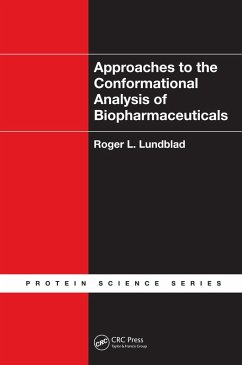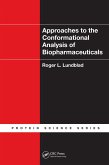Roger L. Lundblad
Approaches to the Conformational Analysis of Biopharmaceuticals (eBook, PDF)
73,95 €
73,95 €
inkl. MwSt.
Sofort per Download lieferbar

37 °P sammeln
73,95 €
Als Download kaufen

73,95 €
inkl. MwSt.
Sofort per Download lieferbar

37 °P sammeln
Jetzt verschenken
Alle Infos zum eBook verschenken
73,95 €
inkl. MwSt.
Sofort per Download lieferbar
Alle Infos zum eBook verschenken

37 °P sammeln
Roger L. Lundblad
Approaches to the Conformational Analysis of Biopharmaceuticals (eBook, PDF)
- Format: PDF
- Merkliste
- Auf die Merkliste
- Bewerten Bewerten
- Teilen
- Produkt teilen
- Produkterinnerung
- Produkterinnerung

Bitte loggen Sie sich zunächst in Ihr Kundenkonto ein oder registrieren Sie sich bei
bücher.de, um das eBook-Abo tolino select nutzen zu können.
Hier können Sie sich einloggen
Hier können Sie sich einloggen
Sie sind bereits eingeloggt. Klicken Sie auf 2. tolino select Abo, um fortzufahren.

Bitte loggen Sie sich zunächst in Ihr Kundenkonto ein oder registrieren Sie sich bei bücher.de, um das eBook-Abo tolino select nutzen zu können.
The activity of many biopharmaceutical polymers is dependent on conformation, and the next several years will see increased interest in the conformational analysis of these polymers resulting from the development of biosimilar or "follow-on" biological products. While a wide variety of approaches to analysis exists, finding the most viable ones wou
- Geräte: PC
- mit Kopierschutz
- eBook Hilfe
Andere Kunden interessierten sich auch für
![Approaches to the Conformational Analysis of Biopharmaceuticals (eBook, ePUB) Approaches to the Conformational Analysis of Biopharmaceuticals (eBook, ePUB)]() Roger L. LundbladApproaches to the Conformational Analysis of Biopharmaceuticals (eBook, ePUB)73,95 €
Roger L. LundbladApproaches to the Conformational Analysis of Biopharmaceuticals (eBook, ePUB)73,95 €![Biomolecular Thermodynamics (eBook, PDF) Biomolecular Thermodynamics (eBook, PDF)]() Douglas BarrickBiomolecular Thermodynamics (eBook, PDF)112,95 €
Douglas BarrickBiomolecular Thermodynamics (eBook, PDF)112,95 €![High-Risk Atherosclerotic Plaques (eBook, PDF) High-Risk Atherosclerotic Plaques (eBook, PDF)]() High-Risk Atherosclerotic Plaques (eBook, PDF)57,95 €
High-Risk Atherosclerotic Plaques (eBook, PDF)57,95 €![AMolecular Description of Biological Membrane Components by Computer Aided Conformational Analysis (eBook, PDF) AMolecular Description of Biological Membrane Components by Computer Aided Conformational Analysis (eBook, PDF)]() Robert BrasseurAMolecular Description of Biological Membrane Components by Computer Aided Conformational Analysis (eBook, PDF)36,95 €
Robert BrasseurAMolecular Description of Biological Membrane Components by Computer Aided Conformational Analysis (eBook, PDF)36,95 €![Personalbedarf und Kosten im medizinischen Laboratorium (eBook, PDF) Personalbedarf und Kosten im medizinischen Laboratorium (eBook, PDF)]() Personalbedarf und Kosten im medizinischen Laboratorium (eBook, PDF)54,99 €
Personalbedarf und Kosten im medizinischen Laboratorium (eBook, PDF)54,99 €![Lipoic Acid (eBook, PDF) Lipoic Acid (eBook, PDF)]() Lipoic Acid (eBook, PDF)62,95 €
Lipoic Acid (eBook, PDF)62,95 €![Biomolecular Thermodynamics (eBook, ePUB) Biomolecular Thermodynamics (eBook, ePUB)]() Douglas BarrickBiomolecular Thermodynamics (eBook, ePUB)112,95 €
Douglas BarrickBiomolecular Thermodynamics (eBook, ePUB)112,95 €-
-
-
The activity of many biopharmaceutical polymers is dependent on conformation, and the next several years will see increased interest in the conformational analysis of these polymers resulting from the development of biosimilar or "follow-on" biological products. While a wide variety of approaches to analysis exists, finding the most viable ones wou
Dieser Download kann aus rechtlichen Gründen nur mit Rechnungsadresse in A, B, BG, CY, CZ, D, DK, EW, E, FIN, F, GR, HR, H, IRL, I, LT, L, LR, M, NL, PL, P, R, S, SLO, SK ausgeliefert werden.
Produktdetails
- Produktdetails
- Verlag: Taylor & Francis eBooks
- Seitenzahl: 366
- Erscheinungstermin: 15. Dezember 2009
- Englisch
- ISBN-13: 9781439807811
- Artikelnr.: 57534219
- Verlag: Taylor & Francis eBooks
- Seitenzahl: 366
- Erscheinungstermin: 15. Dezember 2009
- Englisch
- ISBN-13: 9781439807811
- Artikelnr.: 57534219
- Herstellerkennzeichnung Die Herstellerinformationen sind derzeit nicht verfügbar.
After postdoctoral work at Rockefeller University, New York, Dr. Roger L. Lundblad joined the faculty of the University of North Carolina at Chapel Hill in 1968. He joined the Hyland division of Baxter Healthcare in 1990. Currently, he is an independent consultant and biotechnology writer based in Chapel Hill, North Carolina. He is an adjunct professor of pathology at the University of North Carolina at Chapel Hill and an editor in chief of the Internet Journal of Genomics and Proteomics.
Introduction to Biopharmaceutical Conformational Analysis: Issues and
Methods. Comparability of Biotechnological/Biological Products and
Biological Generics. Application of Native Electrophoresis for the Study of
Protein Conformation. Affinity Chromatography Including Hydrophobic
Interaction Chromatography in the Study of Biopolymer Conformation.
Size-Exclusion Chromatography and Biomolecular Conformation. Use of
Analytical Ultracentrifugation to Study Biomolecular Conformation. Use of
Differential Scanning Calorimetry to Measure Conformational Change in
Proteins and Other Biomacromolecules. Light Scattering and
Biomacromolecular Conformation. Use of Luminescence to Measure
Conformational Change in Biopharmaceuticals with Emphasis on Protein and
Protein Drug Products. Near-Infrared Spectroscopy and Macromolecular
Conformation. The Use of Mid-Infrared and Fourier Transform Infrared
Spectroscopy to Study Conformation of Biomacromolecules. Use of Raman
Spectroscopy to Evaluate Biopharmaceutical Conformation. Use of UV-VIS
Spectrophotometry for the Characterization of Biopharmaceutical Products.
Use of Optical Rotatory Dispersion and Circular Dichroism to Study
Therapeutic Biomacromolecule Conformation. Use of Nuclear Magnetic
Resonance for the Characterization of Biotherapeutic Products. Use of
Chemical Probes for the Study of Protein Conformation. Use of Hydrogen
Exchange in the Study of Biopharmaceutical Conformation. Use of Chemical
Modifi cation for the Conformational Analysis of Biopharmaceuticals. Use of
Immunology to Characterize Biopharmaceutical Conformation. Use of Limited
Proteolysis to Study the Conformation of Proteins of Biotechnology
Interest. Other Technologies for the Characterization of Conformational
Change in Biopharmaceuticals. Development of an Experimental Approach for
the Study of the Conformation of a Biological Therapeutic Product.
Methods. Comparability of Biotechnological/Biological Products and
Biological Generics. Application of Native Electrophoresis for the Study of
Protein Conformation. Affinity Chromatography Including Hydrophobic
Interaction Chromatography in the Study of Biopolymer Conformation.
Size-Exclusion Chromatography and Biomolecular Conformation. Use of
Analytical Ultracentrifugation to Study Biomolecular Conformation. Use of
Differential Scanning Calorimetry to Measure Conformational Change in
Proteins and Other Biomacromolecules. Light Scattering and
Biomacromolecular Conformation. Use of Luminescence to Measure
Conformational Change in Biopharmaceuticals with Emphasis on Protein and
Protein Drug Products. Near-Infrared Spectroscopy and Macromolecular
Conformation. The Use of Mid-Infrared and Fourier Transform Infrared
Spectroscopy to Study Conformation of Biomacromolecules. Use of Raman
Spectroscopy to Evaluate Biopharmaceutical Conformation. Use of UV-VIS
Spectrophotometry for the Characterization of Biopharmaceutical Products.
Use of Optical Rotatory Dispersion and Circular Dichroism to Study
Therapeutic Biomacromolecule Conformation. Use of Nuclear Magnetic
Resonance for the Characterization of Biotherapeutic Products. Use of
Chemical Probes for the Study of Protein Conformation. Use of Hydrogen
Exchange in the Study of Biopharmaceutical Conformation. Use of Chemical
Modifi cation for the Conformational Analysis of Biopharmaceuticals. Use of
Immunology to Characterize Biopharmaceutical Conformation. Use of Limited
Proteolysis to Study the Conformation of Proteins of Biotechnology
Interest. Other Technologies for the Characterization of Conformational
Change in Biopharmaceuticals. Development of an Experimental Approach for
the Study of the Conformation of a Biological Therapeutic Product.
Introduction to Biopharmaceutical Conformational Analysis: Issues and
Methods. Comparability of Biotechnological/Biological Products and
Biological Generics. Application of Native Electrophoresis for the Study of
Protein Conformation. Affinity Chromatography Including Hydrophobic
Interaction Chromatography in the Study of Biopolymer Conformation.
Size-Exclusion Chromatography and Biomolecular Conformation. Use of
Analytical Ultracentrifugation to Study Biomolecular Conformation. Use of
Differential Scanning Calorimetry to Measure Conformational Change in
Proteins and Other Biomacromolecules. Light Scattering and
Biomacromolecular Conformation. Use of Luminescence to Measure
Conformational Change in Biopharmaceuticals with Emphasis on Protein and
Protein Drug Products. Near-Infrared Spectroscopy and Macromolecular
Conformation. The Use of Mid-Infrared and Fourier Transform Infrared
Spectroscopy to Study Conformation of Biomacromolecules. Use of Raman
Spectroscopy to Evaluate Biopharmaceutical Conformation. Use of UV-VIS
Spectrophotometry for the Characterization of Biopharmaceutical Products.
Use of Optical Rotatory Dispersion and Circular Dichroism to Study
Therapeutic Biomacromolecule Conformation. Use of Nuclear Magnetic
Resonance for the Characterization of Biotherapeutic Products. Use of
Chemical Probes for the Study of Protein Conformation. Use of Hydrogen
Exchange in the Study of Biopharmaceutical Conformation. Use of Chemical
Modifi cation for the Conformational Analysis of Biopharmaceuticals. Use of
Immunology to Characterize Biopharmaceutical Conformation. Use of Limited
Proteolysis to Study the Conformation of Proteins of Biotechnology
Interest. Other Technologies for the Characterization of Conformational
Change in Biopharmaceuticals. Development of an Experimental Approach for
the Study of the Conformation of a Biological Therapeutic Product.
Methods. Comparability of Biotechnological/Biological Products and
Biological Generics. Application of Native Electrophoresis for the Study of
Protein Conformation. Affinity Chromatography Including Hydrophobic
Interaction Chromatography in the Study of Biopolymer Conformation.
Size-Exclusion Chromatography and Biomolecular Conformation. Use of
Analytical Ultracentrifugation to Study Biomolecular Conformation. Use of
Differential Scanning Calorimetry to Measure Conformational Change in
Proteins and Other Biomacromolecules. Light Scattering and
Biomacromolecular Conformation. Use of Luminescence to Measure
Conformational Change in Biopharmaceuticals with Emphasis on Protein and
Protein Drug Products. Near-Infrared Spectroscopy and Macromolecular
Conformation. The Use of Mid-Infrared and Fourier Transform Infrared
Spectroscopy to Study Conformation of Biomacromolecules. Use of Raman
Spectroscopy to Evaluate Biopharmaceutical Conformation. Use of UV-VIS
Spectrophotometry for the Characterization of Biopharmaceutical Products.
Use of Optical Rotatory Dispersion and Circular Dichroism to Study
Therapeutic Biomacromolecule Conformation. Use of Nuclear Magnetic
Resonance for the Characterization of Biotherapeutic Products. Use of
Chemical Probes for the Study of Protein Conformation. Use of Hydrogen
Exchange in the Study of Biopharmaceutical Conformation. Use of Chemical
Modifi cation for the Conformational Analysis of Biopharmaceuticals. Use of
Immunology to Characterize Biopharmaceutical Conformation. Use of Limited
Proteolysis to Study the Conformation of Proteins of Biotechnology
Interest. Other Technologies for the Characterization of Conformational
Change in Biopharmaceuticals. Development of an Experimental Approach for
the Study of the Conformation of a Biological Therapeutic Product.







